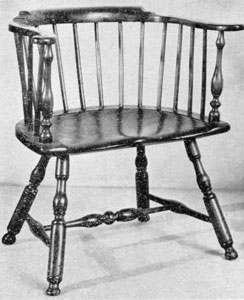Antique and Vintage Chairs

Furniture of the Future: Victorian New York's Most Visionary Designer Loved His Machines
By Hunter Oatman-Stanford — When George Jakob Hunzinger patented his first piece of furniture in December of 1860, the United States was on the brink of a devastating Civil War. Amid the growing pressures of industrialization, the country was split between those in favor of an old-fashioned business model—dependent on slavery—and those betting on a more diversified, innovative economy. At the time, the American way of life as we know it today was hardly recognizable: Gas-powered automobiles hadn’t made their debut;...

In the Hot Seat: Is Your Antique Windsor a Fake?
By Lisa Hix — While researching her book, , Maureen Stanton came across all sorts of characters. For years, she shadowed her antiques-dealer friend she calls “Curt Avery,” and he gave her an insider’s view of what goes on behind-the-scenes in the antiques world—including at Brimfield Antiques Show in Massachusetts, one of the largest flea markets in the United States. Most of the dealers she met were like Avery, honest businessmen who genuinely love to share the history of objects. "If people are...

The Windsor, A Perfectly Designed Chair
By Richmond Huntley — If the Windsor chair had been invented in the 20th Century it would have been classified as functional furniture and rightly so. Perfectly adjusted to the human body, using no excess of material, it had all the sturdiness of the modern chairs of metal tubing without their bent-pipe severity. Yet when it first came to popular notice, back in the early 18th Century, no one called it anything in particular, since the age of labels had not arrived. It was just a simple piece of cottage...

Sources of American Chair Design in the Federal Period
By Helen Cornstock — It was the late R. T. Haynes Halsey who first noted that as early as 1775 there was a project in Philadelphia to publish working designs for furniture makers, a Gentlemen and Cabinet-Makers' Assistant, in which John Norman was to engrave 200 designs by John Folwell. The plan was never realized because of the tumultuous revolutionary events about to commence, but it is a significant indication that the American cabinetmaker had reached a stage of advancement in which he was becoming ever more...

Two Centuries of Comfort
By Bruce Millar — (American Collector Editor’s Note: Some three years ago Mr. Millar, a general collector of American antiques, became especially interested in the roundabout chair. Since then, one at a time, he has gathered a collection of about forty. His preference having been always for the simple antiques of small-town and farm origin, his roundabout chair collection is naturally dominated by those of that type rather than the sophisticated ones of Boston, Newport, and Philadelphia. American...

Slat Back Chairs in Europe and America
By Thomas Hamilton Ormsbee — A winter or two ago Connecticut basket-maker made a set of six three-slat side chairs from basket stock of ash and oak which he had on hand. Although his shop was less than a hundred miles from the Metropolitan Museum of Art, he had never been in the American Wing. There was not an antique in his house; nor did he borrow a model from a neighbor. Deep snow had interrupted his regular work and his wife needed chairs. So, from recollection, the tools in his shop, and skill in working with wood...

Eames, Nelson, and the Mid-Century Modern Aesthetic
By Maribeth Keane — In this interview, Steve Cabella talks about collecting the work of designers Charles and Ray Eames, and about the mid century modern movement. As a teenager, I collected everything from vintage bicycles to Coca-Cola to Victorian stuff. Once I realized some of this stuff contained concepts of art and design, I started looking for vintage objects that also represented art or design movements that could hold my interest. I ran across Art Nouveau and then Art Deco and then Arts and...

The International Influences of Buffalo Furniture
By Maribeth Keane — About 11 years ago, my wife and I went on some architectural tours. We joined the organization that sponsored the tours, and I volunteered to be the Webmaster for them. I decided to take a few photographs to illustrate the tours, and realized it would also be good to describe some of the architecture, so I started an architectural dictionary. Then I decided it would be useful to have some Buffalo history, as background for the architecture, so I started working on that. Then I started...